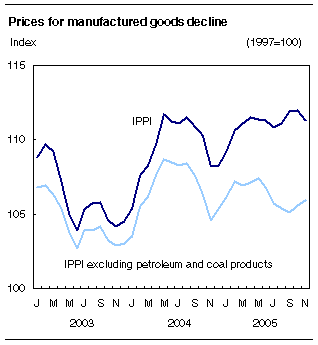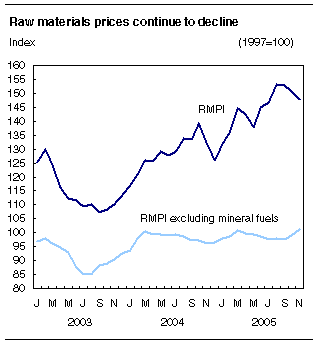
















 |
|
 |                |
Information identified as archived is provided for reference, research or recordkeeping purposes. It is not subject to the Government of Canada Web Standards and has not been altered or updated since it was archived. Please "contact us" to request a format other than those available.

|

Wednesday, January 4, 2006 Industrial product and raw materials price indexesNovember 2005Prices for manufactured goods at the factory gate were down in November, as gasoline and fuel oil prices declined for a second month. Raw materials prices were down for a third consecutive month in November, due to lower prices for crude oil. Prices charged by manufacturers, as measured by the Industrial Product Price Index (IPPI), were down 0.6% from October to November. Lower prices for petroleum products and lumber products were the major contributors to this monthly decrease. 
The 12-month change in the IPPI was 2.9%, up from October's year-over-year increase of 1.5% and largely due to higher prices for petroleum products as well as chemical products compared to one year ago. The Raw Materials Price Index (RMPI) was down 1.7% from October to November, following a 1.5% decline the previous month. There were price decreases in mineral fuels, vegetable products and non-metallic minerals.
Compared to November 2004, raw materials cost factories 12.1% more, up from the 12-month change of 8.2% in October. The IPPI (1997=100) stood at 111.3 in November, down from October's revised level of 112.0. The RMPI (1997=100) stood at 147.9, down from a revised level of 150.5 in October. IPPI: Prices for petroleum and lumber products declineOn a month-over-month basis, manufacturers' prices were down 0.6% as gasoline and fuel oil prices dropped. Petroleum and coal products prices declined 8.7% compared to October, the largest decrease since May 2003. If petroleum and coal product prices had been excluded, the IPPI would have increased 0.3% rather than decreasing 0.6%. Lumber and other wood products decreased 2.0%, the result of lower prices for particleboard and softwood type plywood. Prices for meat, fish and dairy products as well as fruit, vegetable and feed products also registered small declines from the previous month. However, primary metal products rose 2.0% as inventories continued to decline for copper, aluminum and zinc and demand remained strong for steel products. Prices for chemical products rose 1.4% due to increases for synthetic resins. Prices for pulp and paper products, rubber, leather and plastic fabricated products, as well as metal fabricated products also increased in November. IPPI: Petroleum and chemical products are the major factors in the 12-month changeOn a 12-month basis, the IPPI was up 2.9% in November, following an increase of 1.5% in October. Prices for petroleum and coal products rose 19.7% from November 2004, down from October's increase of 24.7%. If petroleum and coal product prices had been excluded, the IPPI would have increased 1.2%, rather than climbing 2.9% from a year ago. Chemical products increased 9.3%, due to higher prices for organic industrial chemicals and synthetic resins. Prices were also higher than one year ago for rubber, leather and plastic fabricated products, machinery and equipment, fruit, vegetable and feed products, electrical and communication products as well as tobacco products. On the other hand, motor vehicles and other transport equipment prices were down 1.1% from a year ago, as a result of a stronger Canadian dollar. Prices for primary metal products were down 1.3% from a year ago as decreases were observed for primary steel products and primary nickel products. Lumber and other wood products declined 0.8% from November 2004 to November 2005, as year-over-year price decreases were recorded for softwood type plywood and softwood lumber. RMPI: Crude oil prices decrease againOn a monthly basis, raw materials prices fell 1.7% in November, following a decline of 1.5% in October. Mineral fuels were down 5.0% compared to October. Crude oil prices decreased 5.8% as inventories remained strong and demand was lower. Vegetable products decreased 0.3% from the previous month as prices were down for natural rubber, raw tobacco and oilseeds. There were also price declines for non-metallic minerals. However, prices for non-ferrous metals rose 5.3%, mainly due to higher prices for zinc concentrates, copper concentrates, radioactive concentrates, and lead concentrates. Prices for wood products increased 1.9% with higher prices for softwood logs and bolts being reported. Prices for animal and animal products rose 1.0% compared to the previous month as increases were registered cattle for slaughter, and sheep and lambs for slaughter. Ferrous materials also increased from the previous month. On a 12-month basis, the price of raw materials rose 12.1% in November, up from the 8.2% year-over-year increase in October. Mineral fuels were up 19.1% with crude oil prices rising 23.0%. If mineral fuels had been excluded, the RMPI would have increased 5.2% instead of rising 12.1%. 
Prices for non-ferrous metals rose 24.6%, mainly because of higher prices for radioactive concentrates, zinc concentrates, copper concentrates and gold. Prices for animal and animal products were up 3.9% from a year ago due to year-over-year increases for cattle for slaughter, unprocessed whole fluid milk and sheep and lambs for slaughter. Higher prices were also observed for non-metallic mineral products and vegetable products. On the other hand, wood products were down 9.6% from a year ago with softwood logs and bolts prices declining 12.4%. Prices for ferrous materials also declined 8.4% compared to November 2004. Impact of the exchange rateBetween October and November, the value of the Canadian fell 0.3% against the US dollar. As a result, the total IPPI excluding the effect of the exchange would have declined 0.7% instead of its actual decrease of 0.6%. On a 12-month basis, the value of the Canadian dollar rose 1.3% against the US dollar. If the impact of the exchange rate had been excluded, producer prices would have risen 3.2% between November 2004 and November 2005, rather than their actual increase of 2.9%. Prices for intermediate goods decreasePrices for intermediate goods decreased 0.4% from October. Lower prices for petroleum products, lumber products and fruit, vegetable and feed products were the major contributors to the decline. Higher prices for primary metals, chemical products and pulp and paper products partially offset the monthly decrease. Producers of intermediate goods received 3.7% more for their goods in November 2005 than in November 2004. Higher prices were registered for petroleum products, chemical products, rubber, leather and plastic fabricated products, pulp and paper products, electrical and communication products, machinery and equipment, and non-metallic mineral products. These increases were partly offset by lower prices for primary metals, motor vehicles, lumber products and meat, fish and dairy products. Finished goods prices declineOn a monthly basis, prices for finished goods were down 1.0% from October. Lower prices for petroleum and lumber products were partially offset by higher prices for motor vehicles, rubber, leather and plastic fabricated products as well as non-metallic mineral products. Compared with November 2004, prices for finished goods were up by 1.4%. Higher prices for petroleum products, machinery and equipment, tobacco products, meat, fish and dairy products, fruit, vegetable and feed products, chemical products, rubber, leather and plastic fabricated products, and furniture and fixtures were the major contributors to the annual increase. Lower prices for motor vehicles, lumber products, and pulp and paper products partly offset the annual increase. Available on CANSIM: tables 329-0038 to 329-0049 and 330-0006. Definitions, data sources and methods: survey numbers, including related surveys, 2306 and 2318. The November 2005 issue of Industry Price Indexes (62-011-XIE, $19/$175, 62-011-XPE, $24/$233) will be available in January. The industrial product and raw material price indexes for December 2005 will be released on January 30. For more information, or to enquire about the concepts, methods or data quality of this release, contact the Client Services Unit (613-951-9606, fax: 613-951-1539, infounit@statcan.gc.ca) or Danielle Gouin (613-951-3375, danielle.gouin@statcan.gc.ca), Prices Division.
| |||||||||||||||||||||||||||||||||||||||||||||||||||||||||||||||||||||||||||||||||||||||||||||||||||||||||||||||||||||||||||||||||||||||||||||||||||||||||||||||||||||||||||||||||||||||||||||||||||||||||||||||||||||||||||||||||||||||||||||||||||||||||||||||||||||||||||||||||||||||||||||||||||||||||||||||||||||||||||||||||||||||||||||||||||||||||||||||||||||||||||||||||
|
|
|